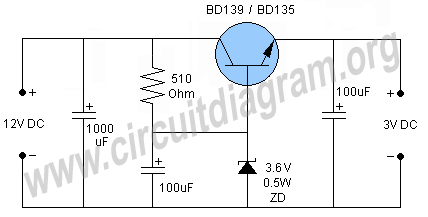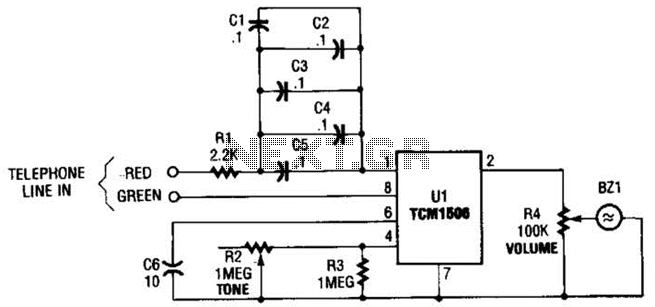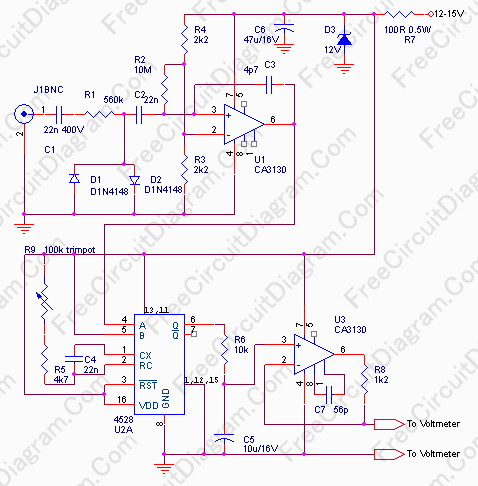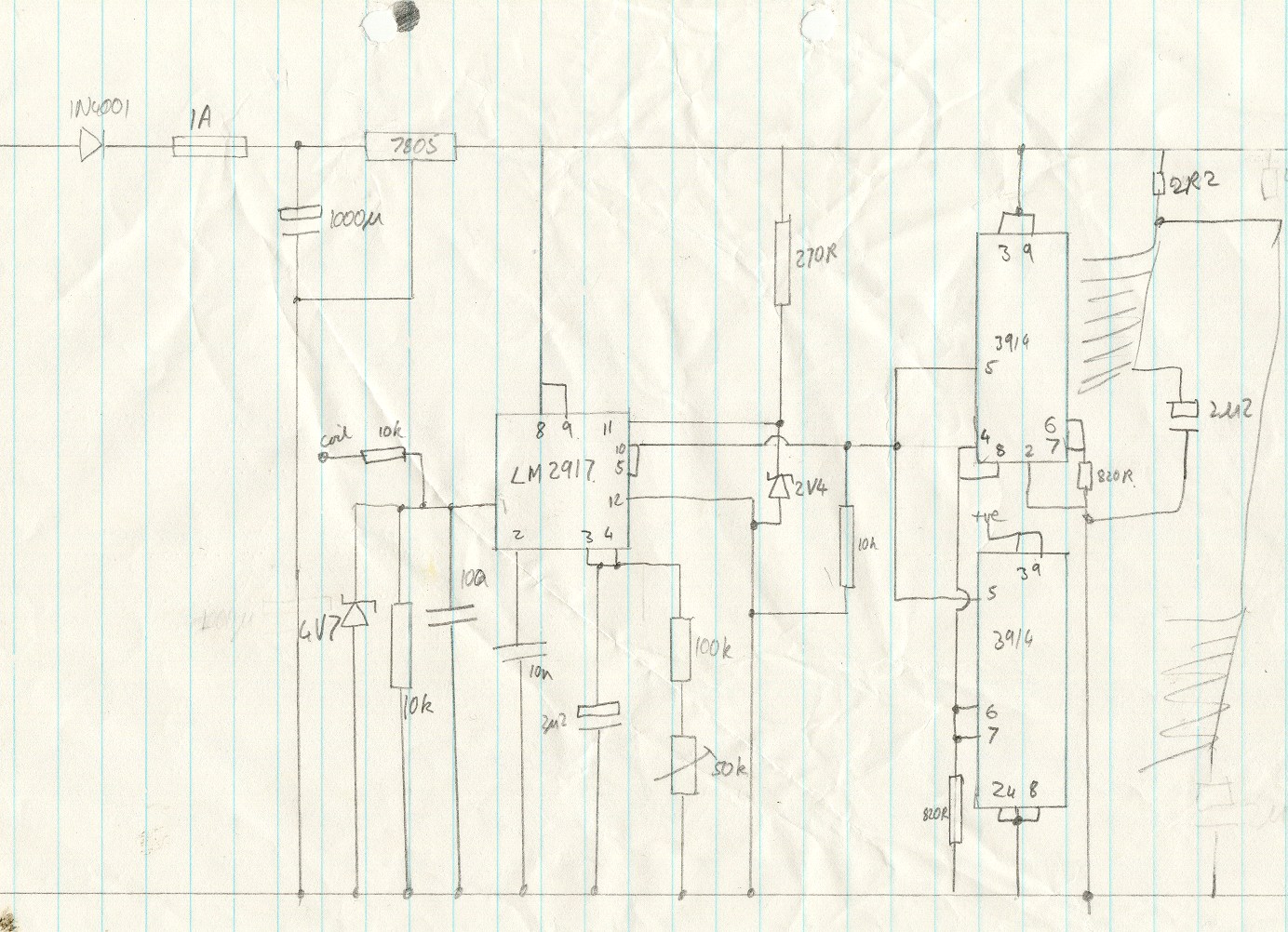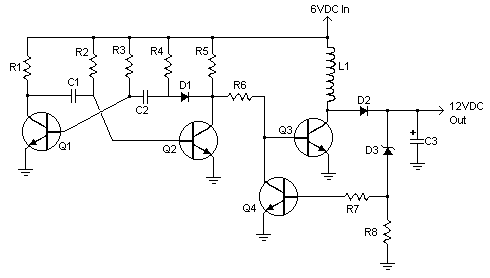
RGB To Color Difference Converter
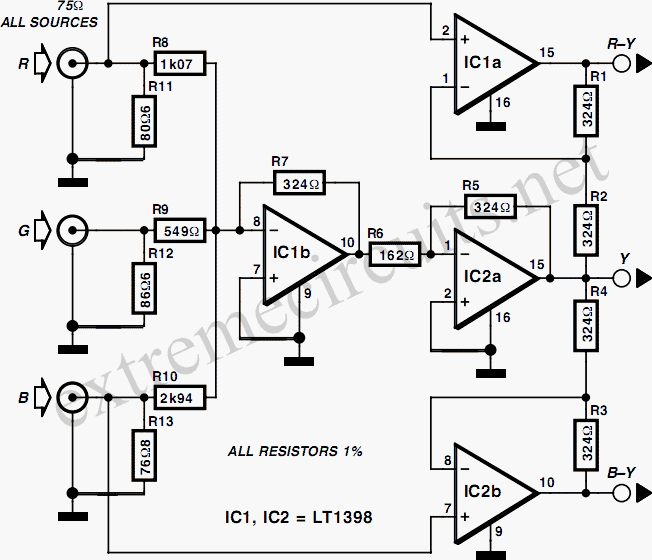
The circuit diagram illustrates two LT1398 operational amplifiers from Linear Technology utilized to generate buffered color-difference signals from RGB (red-green-blue) inputs. In this setup, the R input is received through a 75-ohm coaxial cable and directed to the non-inverting input of amplifier IC1a and a 1.07-kilohm resistor, R8. An additional 80.6-ohm termination resistor, R11, is included, which together with R8, provides a 75-ohm input impedance at the R input when viewed in parallel. R8 connects to the inverting input of a second LT1398 amplifier (IC1b), which combines the weighted G and B inputs to produce a 0.5Y output. A third LT1398 amplifier, IC2a, subsequently amplifies the 0.5Y output by a gain of 2, yielding the +Y output. Amplifier IC1a is set up for a non-inverting gain of 2, with the bottom of the gain resistor R2 connected to the Y output, resulting in the color-difference output R-Y. The B input follows a similar configuration as the R input, where R13, in parallel with R10, creates a 75-ohm input impedance. R10 is also linked to the inverting input of amplifier IC1b, contributing the B signal to the Y output as previously mentioned. Amplifier IC2b is configured to provide a non-inverting gain of 2, with the bottom of the gain resistor R4 connected to the Y output, resulting in the color-difference output B-Y. The G input is also received through a 75-ohm coaxial cable and adds its contribution to the Y signal through resistor R9, which connects to the inverting input of amplifier IC1b. Resistors R12 and R9 ensure a 75-ohm termination impedance. By applying superposition, the output of IC1b can be determined, which, although inverted, combines the R, G, and B signals in the standard proportions of 0.3R, 0.59G, and 0.11B to create the Y signal. Amplifier IC2a then inverts and amplifies the signal by a factor of 2, producing the final Y output. The converter operates with a current draw of approximately 30mA from a symmetrical 5-volt power supply.
The circuit utilizes two LT1398 operational amplifiers, which are precision devices known for their low noise and high-speed performance, making them suitable for applications requiring accurate signal processing. The architecture is designed to handle RGB signals, with each color channel processed through dedicated paths that ensure minimal signal degradation and optimal impedance matching.
The operational amplifiers are configured to perform both summation and amplification tasks. IC1a is tasked with creating the R-Y color difference signal, while IC2a amplifies the Y signal for further processing. Similarly, IC1b combines the contributions from the G and B channels to produce the B-Y signal, ensuring that the output signals are appropriately scaled for downstream applications.
The use of 75-ohm coaxial cables indicates that the circuit is intended for high-frequency applications, such as video signal processing, where maintaining signal integrity is crucial. The termination resistors R11, R8, R10, and R12 are strategically placed to match the characteristic impedance of the coaxial cables, minimizing reflections and signal loss.
In summary, this circuit diagram represents a sophisticated approach to generating color-difference signals from RGB inputs, employing careful design considerations to ensure high fidelity and accurate signal processing in electronic applications. The overall design is efficient, drawing a modest current from a stable power supply while maintaining the integrity of the input signals throughout the amplification and processing stages.The circuit diagram shows two LT1398`s from Linear Technology used to create buffered color-difference signals from RGB (red-green-blue) inputs. In this application, the R input arrives via 75 coax. It is routed to the non-inverting input of amplifier IC1a and to 1. 07-k resistor, R8. There is also an 80. 6- termination resistor R11, which yields a 75- input impedance at the R input when considered in parallel with R8. R8 connects to the inverting input of a second LT1398 amplifier (IC1b), which also sums the weighted G and B inputs to create a 0. 5Y output. Yet another LT1398 amplifier, IC2a, then takes the 0. 5Y output and amplifies it by a gain of 2, resulting in the +Y output. Amplifier IC1a is configured for a non-inverting gain of 2 with the bottom of the gain resistor R2 tied to the Y output.
The output IC1a thus results in the color-difference output R Y. The B input is similar to the R input. Here, R13 when considered in parallel with R10 yields a 75- input impedance. R10 also connects to the inverting input of amplier IC1b, adding the B contribution to the Y signal as discussed above. Amplifier IC2b is congured to supply a non-inverting gain of 2 with the bottom of the gain resistor R4 tied to the Y output.
The output of IC2b thus results in the color-difference output B Y. The G input also arrives via 75- coax and adds its contribution to the Y signal via resistor R9, which is tied to the inverting input of amplifier IC1b. Here, R12 and R9 provide the 75 termination impedance. Using superposition, it is straightforward to determine the output of IC1b. Although inverted, it sums the R, G and B signals to the standard proportions of 0. 3R, 0. 59G and 0. 11B that are used to create the Y signal. Amplifier IC2a then inverts and amplifies the signal by 2, resulting in the Y output. The converter draws a current of about 30mA from a symmetrical 5-volt supply. 🔗 External reference
The circuit utilizes two LT1398 operational amplifiers, which are precision devices known for their low noise and high-speed performance, making them suitable for applications requiring accurate signal processing. The architecture is designed to handle RGB signals, with each color channel processed through dedicated paths that ensure minimal signal degradation and optimal impedance matching.
The operational amplifiers are configured to perform both summation and amplification tasks. IC1a is tasked with creating the R-Y color difference signal, while IC2a amplifies the Y signal for further processing. Similarly, IC1b combines the contributions from the G and B channels to produce the B-Y signal, ensuring that the output signals are appropriately scaled for downstream applications.
The use of 75-ohm coaxial cables indicates that the circuit is intended for high-frequency applications, such as video signal processing, where maintaining signal integrity is crucial. The termination resistors R11, R8, R10, and R12 are strategically placed to match the characteristic impedance of the coaxial cables, minimizing reflections and signal loss.
In summary, this circuit diagram represents a sophisticated approach to generating color-difference signals from RGB inputs, employing careful design considerations to ensure high fidelity and accurate signal processing in electronic applications. The overall design is efficient, drawing a modest current from a stable power supply while maintaining the integrity of the input signals throughout the amplification and processing stages.The circuit diagram shows two LT1398`s from Linear Technology used to create buffered color-difference signals from RGB (red-green-blue) inputs. In this application, the R input arrives via 75 coax. It is routed to the non-inverting input of amplifier IC1a and to 1. 07-k resistor, R8. There is also an 80. 6- termination resistor R11, which yields a 75- input impedance at the R input when considered in parallel with R8. R8 connects to the inverting input of a second LT1398 amplifier (IC1b), which also sums the weighted G and B inputs to create a 0. 5Y output. Yet another LT1398 amplifier, IC2a, then takes the 0. 5Y output and amplifies it by a gain of 2, resulting in the +Y output. Amplifier IC1a is configured for a non-inverting gain of 2 with the bottom of the gain resistor R2 tied to the Y output.
The output IC1a thus results in the color-difference output R Y. The B input is similar to the R input. Here, R13 when considered in parallel with R10 yields a 75- input impedance. R10 also connects to the inverting input of amplier IC1b, adding the B contribution to the Y signal as discussed above. Amplifier IC2b is congured to supply a non-inverting gain of 2 with the bottom of the gain resistor R4 tied to the Y output.
The output of IC2b thus results in the color-difference output B Y. The G input also arrives via 75- coax and adds its contribution to the Y signal via resistor R9, which is tied to the inverting input of amplifier IC1b. Here, R12 and R9 provide the 75 termination impedance. Using superposition, it is straightforward to determine the output of IC1b. Although inverted, it sums the R, G and B signals to the standard proportions of 0. 3R, 0. 59G and 0. 11B that are used to create the Y signal. Amplifier IC2a then inverts and amplifies the signal by 2, resulting in the Y output. The converter draws a current of about 30mA from a symmetrical 5-volt supply. 🔗 External reference
